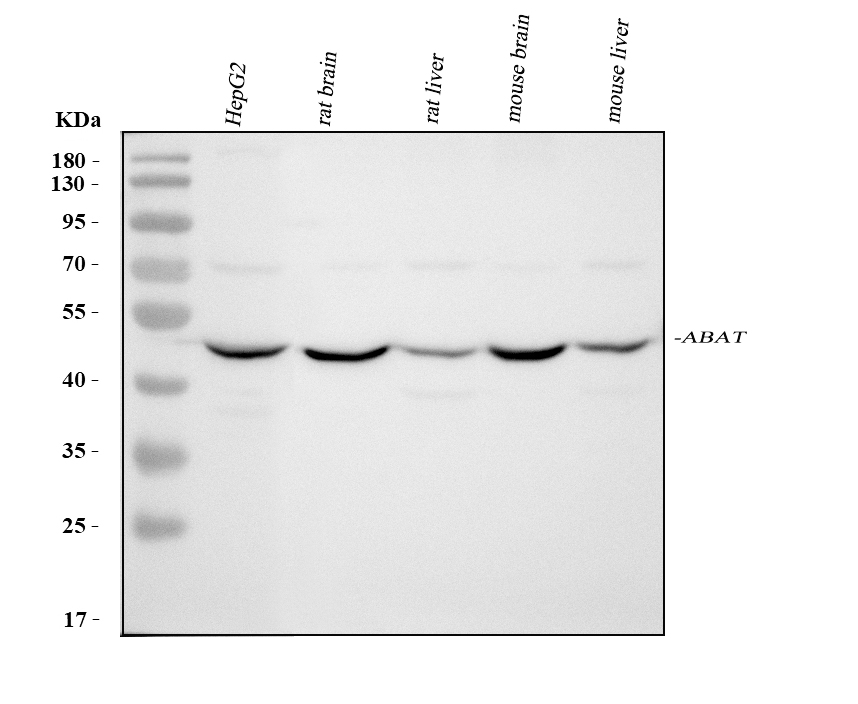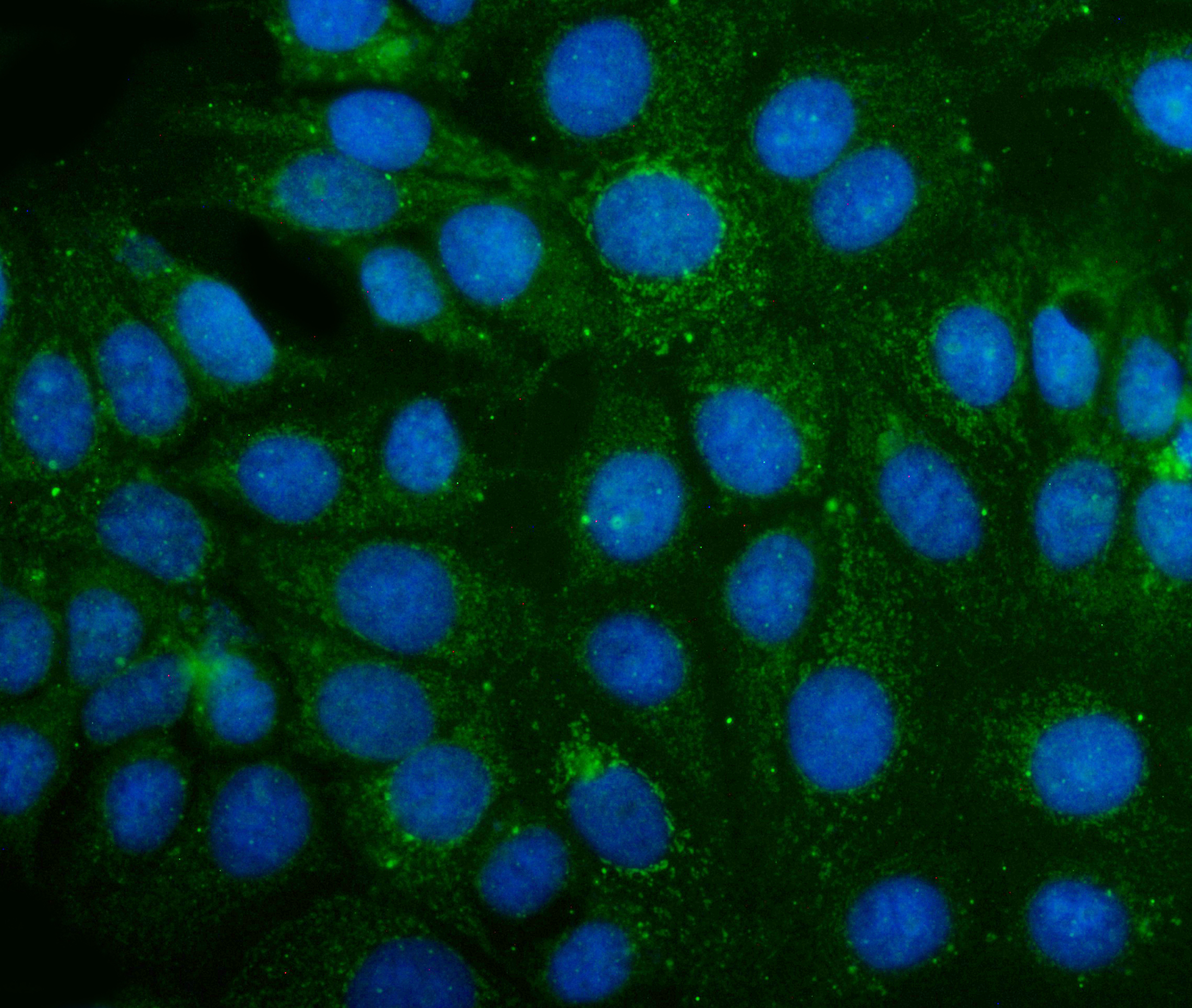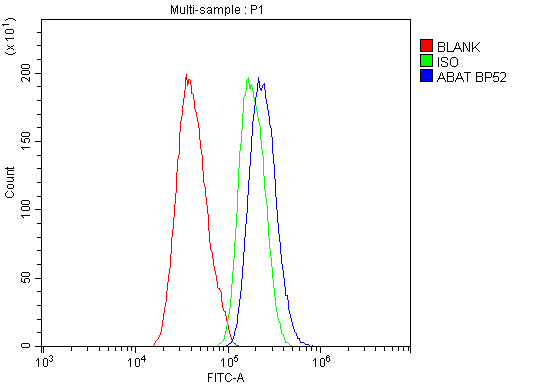| Western blot (WB): | 1:500-2000 |
| ICC/IF: | 1:50-1:200 |
| Flow Cytometry (Fixed): | 1:50-200 |

Western blot analysis of ABAT using anti-ABAT antibody (PB1071). The sample well of each lane was loaded with 30 ug of sample under reducing conditions.
Lane 1: HepG2 whole cell lysates,
Lane 2: rat brain tissue lysates,
Lane 3: rat liver tissue lysates,
Lane 4: mouse brain tissue lysates,
Lane 5: mouse liver tissue lysates.
After electrophoresis, proteins were transferred to a membrane. Then the membrane was incubated with rabbit anti-ABAT antigen affinity purified polyclonal antibody (PB1071) at a dilution of 1:1000 and probed with a goat anti-rabbit IgG-HRP secondary antibody (Catalog # BA1054). The signal is developed using ECL Plus Western Blotting Substrate (Catalog # AR1197). A specific band was detected for ABAT at approximately 54 kDa. The expected band size for ABAT is at 56 kDa.

ICC/IF analysis of ABAT using anti-ABAT antibody (PB1071).
ABAT was detected in an immunocytochemical section of MCF-7 cells. The section was incubated with rabbit anti-ABAT Antibody (PB1071) at a dilution of 1:100. Fluoro488 Conjugated Goat Anti-Rabbit IgG (Green) (Catalog # BA1127) was used as secondary antibody. The section was counterstained with DAPI (Catalog # AR1176) (Blue).

Flow Cytometry analysis of Caco-2 cells using anti-ABAT antibody (PB1071).
Overlay histogram showing Caco-2 cells stained with PB1071 (Blue line). To facilitate intracellular staining, cells were fixed with 4% paraformaldehyde and permeabilized with permeabilization buffer. The cells were blocked with 10% normal goat serum. And then incubated with rabbit anti-ABAT Antibody (PB1071) at 1:100 dilution for 30 min at 20°C. Fluoro488 conjugated goat anti-rabbit IgG (BA1127) was used as secondary antibody at 1:100 dilution for 30 minutes at 20°C. Isotype control antibody (Green line) was rabbit IgG at 1:100 dilution used under the same conditions. Unlabelled sample without incubation with primary antibody and secondary antibody (Red line) was used as a blank control.

Western blot analysis of ABAT using anti-ABAT antibody (PB1071). The sample well of each lane was loaded with 30 ug of sample under reducing conditions.
Lane 1: HepG2 whole cell lysates,
Lane 2: rat brain tissue lysates,
Lane 3: rat liver tissue lysates,
Lane 4: mouse brain tissue lysates,
Lane 5: mouse liver tissue lysates.
After electrophoresis, proteins were transferred to a membrane. Then the membrane was incubated with rabbit anti-ABAT antigen affinity purified polyclonal antibody (PB1071) at a dilution of 1:1000 and probed with a goat anti-rabbit IgG-HRP secondary antibody (Catalog # BA1054). The signal is developed using ECL Plus Western Blotting Substrate (Catalog # AR1197). A specific band was detected for ABAT at approximately 54 kDa. The expected band size for ABAT is at 56 kDa.

ICC/IF analysis of ABAT using anti-ABAT antibody (PB1071).
ABAT was detected in an immunocytochemical section of MCF-7 cells. The section was incubated with rabbit anti-ABAT Antibody (PB1071) at a dilution of 1:100. Fluoro488 Conjugated Goat Anti-Rabbit IgG (Green) (Catalog # BA1127) was used as secondary antibody. The section was counterstained with DAPI (Catalog # AR1176) (Blue).

Flow Cytometry analysis of Caco-2 cells using anti-ABAT antibody (PB1071).
Overlay histogram showing Caco-2 cells stained with PB1071 (Blue line). To facilitate intracellular staining, cells were fixed with 4% paraformaldehyde and permeabilized with permeabilization buffer. The cells were blocked with 10% normal goat serum. And then incubated with rabbit anti-ABAT Antibody (PB1071) at 1:100 dilution for 30 min at 20°C. Fluoro488 conjugated goat anti-rabbit IgG (BA1127) was used as secondary antibody at 1:100 dilution for 30 minutes at 20°C. Isotype control antibody (Green line) was rabbit IgG at 1:100 dilution used under the same conditions. Unlabelled sample without incubation with primary antibody and secondary antibody (Red line) was used as a blank control.


